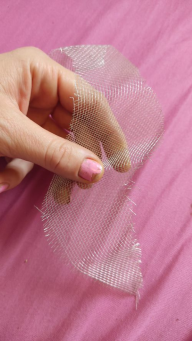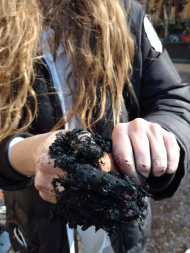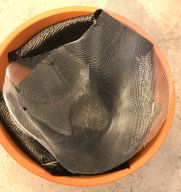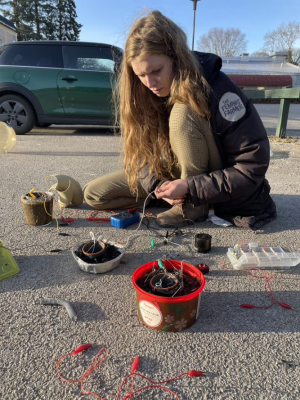MFC
Power up with an Anaerobic work out
Refuturing our imaginations when it comes to energy generation, electrical technologies, waste, and the power dynamics which permeate these narratives, is at the core of this ongoing project. Uncovering wild electricity by making Microbial Fuel Cells from non-specialist and environmentally friendly materials - and seeing what and how we can power things with them.
Making our own electricity from scratch, the project aims to empower us end users of electricity, while questioning and demystifying the mainstream narratives of production, storage, transmission and consumption of this curious force. Working with the magical world of microbes, we can gain a deeper respect for these vital organisms, while investigating how electronics can work with such low power. It also gives us an occasion learn from other organisms who work with electricity in a regenerative way in their ecosystems, instead of in a toxic way, like much human engineering does.
In line with ideas of regenerative practices, where maintaining or sustaining is usurped by the drive to improve or enhance the environment, the electricity-producing MFCs have the multi-function of simultaneous wastewater treatment and nutrient recovery which can help to restore soil health. Reference Galjda et al
Exploring bio-materials, eco-electronics and rethinking how we think about waste, The project aims to foster a culture of radical sustainability and awareness relating to energy generation and usage, and provide us with hands-on, yet playful, energetic agency.
Caring for Microorganisms = Caring for our Bodies = Caring for the Planet
+ Depending on your application, you can play around with putting the cells in parallel and/ or series - putting them in series (- to +, - to +...) will make a higher voltage, and putting them in parallel (+ to +, - to -), will create more current / amps.
Fermented food, soil, mud and water is alive. it poetically brings to mind an animistic world
where the air that we breath and the food that we eat is in constant movement.
If you listen and smell carefully, you could note how the activity in the Jars changes the sound and olfactory environment.
Even though they are super small, there are so many of them, and so many different types. They play a big role in aLL ecosystemS - including our own bodies. Caring for helpful micro-organisms means a healthy body and planet!
By connecting the electrical activity of the microbes found where there is no oxygen, and who give off electricity when they eat, to our synthesisers, we can get an idea, using our sense of sound, of how happy and healthy the MICRObiome is. We are only using old sauerkraut rescued from a sauerkraut factory for this experiment.
FUEL CELL INGREDIENTS

+ Ceramic Plant pot diameter - 1 per fuel cell. Many smaller ones work better than big ones.
+ graphite powder - 1 tablespoon per cell (art stores sell this) or you can use graphite spray (noxious and expensive)
+ Gluten powder to make seitan, for the electrode, which you can also make yourself from wheat flour (~ 6 spoons for 4 cells) OR carbon cloth (expensive)
+ If not using carbon cloth, then you would need activated charcoal powder to mix with the seitan (6 spoons for 4 cells). You can find this at aquarium stores for cheap, but also health food stores etc.
OR we make our own: need a bag of fire wood, ,lemons, equipment: large sealable glass containers, stovetop, large metal cooking pot, food processor, sieve, surgical/dust mask. This is cheaper and more primal + hands-on, also to collect the ash which we could use later on to capture nitrogen if using urine, and neutralize the smell.
+ non-corrosive wire - aprox. 5cm per fuel cell OR thick solder also works (lead-free)

+ crocodile clips: 2 per cell
+ wooden stick, the same diameter as the ceramic pot’s holes, and/or some glue or putty (non-conductive, non-porous, water tight) to fill the drainage hole of the plant pot (without it we would make a short circuit!)
+ Fine, flexible Aluminium Mesh (Sometimes sold as “Insect Mesh” at hardware stores)
INSTRUCTIONS:
001 Charcoal Cathode
+ Fill holes of pots with wood/ glue / putty and let it dry.
+ If you have carbon cloth, you can cut a piece and wrap it on the inside of the pot, and then skip the rest of the steps below, but you need to put aluminium mesh on too (this acts as the “current collector”)
+ If you are making your bioelectrodes from scratch: Make dry mixture of 50% gluten powder to 50% activated charcoal. Sometimes the activated charcoal isn’t in powder form, but try mash it up as much as possible if you have the granules.

+ Add +- 250ml of water, kneading well, until you have a kind of pastey-putty. It’s pretty hard to work with – but this is why we use it, as it keeps its shape, even in liquid.
+ Make a rectangle of the putty and Sculpt it onto the inside of the ceramic pot. Take care to not get it on the top lip of the pot (short circuit!), and to try have an even covering over the pot, including the base.
+ If you have access to a microwave then put in the pots for about 8-10 minutes on high (with a cool down break in between) – keep a close watch for them getting too dry and catching on fire!
+ Cut a piece of aluminium mesh and wrap it on the inside of the pot, trying to make as much contact with the electrode as possible. If you don’t have a microwave, but have an oven you can do this step with the wet electrodes, and bake them together for extra conductivity. Bake them on a low-ish setting until they have puffed up and are totally hard.
+ The longer it can dry out, the better.

002 Graphite Anode
+ Dip your finger into the graphite powder and rub / smear it onto the outside of the ceramic pot, until it’s all covered in a smooth, even layer, taking care to not make a short circuit with the cathode.
+ Find a way to make contact with the non-corrosive wire and the graphite on the pot. This can be tricky, but you could put the pot on top of the wire, attach with an elastic band, or even just lean it on. If you come up with a better design, please share! I found that making holders of aluminium foil for the bottom doesn’t work so well, as if there is any liquid leaking from the bottom (even just throught he porous ceramic), it will make a short circuit, and so its not so good.
003 Where The Magic Happens
+ 3/4 Fill your pot with the cathode with your anaerobic substrate of choice - urine, compost, old ferments, mud, mini swamps, chicken poo, .... If your substrate is too solid (e.g. cow poo), mix some water with it – wild water with its own microorganisms is best.
+Take care not to disrupt any ecosystems when collecting substrate, or wasting edible food - only use things that are going to “waste”. healthy topsoil, for instance, is in a state of global crisis, so we do not want to remove this from ecosystems.
What’s best is if you are making compost, this fuel cell acts as the biodigester, while things get broken down. This means that in the composting process, you can also get some electricity out!
+ Take out the multimeter, attach the cathode crocodile clip to the negative (-) terminal of the multimeter, and the anode to the positive (+).
+ TEST THE VOLTAGE!
+ HOW TO USE VOLTMETER
004 Using the Cells
